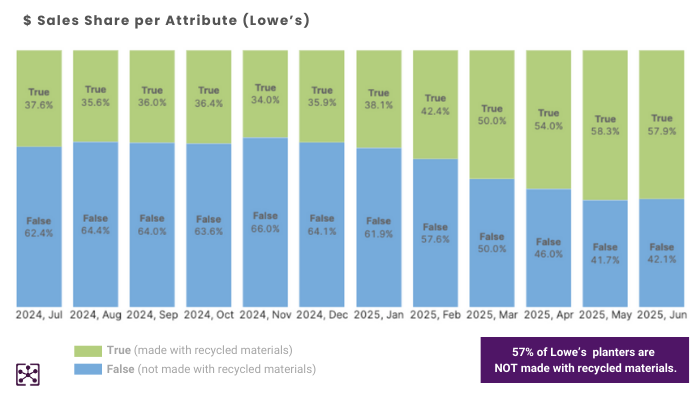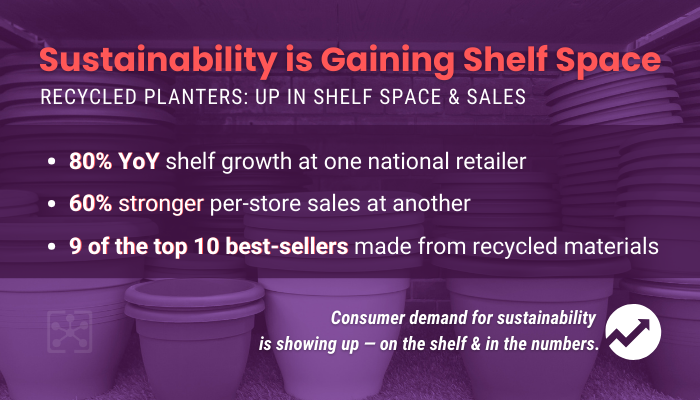Sustainability That Sells
.png)
The term “sustainability” has been a corporate buzzword since the start of this century. However, in the last decade we have seen a serious shift from a mere buzzword to a bottom-line driver that makes a clear difference in brand revenue and reputation. Whether a product is recycled, recyclable, or sustainably sourced is a key factor in consumer decision making and a growing determinant of retail shelf space. Across industries, buyers are showing a growing preference for eco-friendly products and brands that fail to keep up risk being left behind.
A recent McKinsey & NielsenIQ study found that products making environmental or social claims saw 28% more cumulative growth over five years than those that didn’t — clear evidence that sustainability sells.1
While this shift is playing out across categories, a closer look at one specific market — planters — offers a compelling case study for what’s happening now and what is coming next.
Lowe’s vs. Home Depot: A Planter Market Snapshot
Currently, Lowe’s is seeing a much higher percentage of its sales coming from planters in comparison to Home Depot. The first question that comes to mind is “why?”, considering the similarities in the retailers’ Lawn & Garden departments. Is it simply a stocking decision or does it reflect a deeper consumer demand?
The short answer is both. However, a deeper dive into the data suggests that consumer preference is the driving force behind this difference. Lowe’s noticed the trend and quickly responded with an updated strategy for their shelf.
Over the past year:
- Lowe’s has expanded the number of stores carrying recycled-materials planters by 50%
- Home Depot actually decreased store count for these items by 10% despite the fact that recycled planters are selling 60% better per store
- Lowe’s now dedicates 43% of its planter shelf space to recycled materials (an 80% YoY growth)
- Home Depot has just 14% of its shelf space dedicated to recycled options (with 28% YoY growth)
The impact here is clear. As a reference point, this quarter Lowe’s top five selling planters — and nine of the top ten overall — were made from recycled materials. This isn’t just a one-off. It’s a consumer signal and Lowe’s is listening.


Why It Matters: Shelf Strategy That Reflects Values
Lowe’s strategy isn’t just selling more planters made from recycled materials. It’s stocking smarter and that is giving it a strategic advantage.
Despite Home Depot’s stronger per-store performance in recycled planters, its decision to reduce store coverage has created a gap between consumer demand and store execution. That gap is costing more than just shelf space and consumer interest — it’s costing market share. Lowe’s on the other hand is doing more than just responding to customer demand, it’s anticipating and making the inventory decisions to support that demand. This trend toward sustainable materials isn’t just limited to planters or the lawn and garden vertical. According to IBISWorld, the sustainable building materials market has outpaced traditional materials with 6.4% annual growth over the past five years. This trend is driven by consumer pressure, evolving regulations, and retailer sustainability targets.2
%20(3).png)
Sustainability Is In Lowe’s DNA
Sustainability is deeply engrained into Lowe’s daily operations and is a key factor in its success. The retailer has been named to the Dow Jones Sustainability Index for North America five years running, scoring especially well in areas like corporate governance and environmental reporting. It has also been recognized by Sustainalytics for lower exposure to ESG-related risks [ESG=Envinromental, Social, and Governance] and named Supplier Engagement Leader by the Carbon Disclosure Project (CDP) for its efforts to reduce emissions across its supplier network. These accolades are not just press release wins. They reflect a broader retail environment that rewards retailers willing to push forward with alignment between consumer values and actual brand actions.
What This Means for Brands
The takeaway here for both manufacturers and suppliers is that sustainability isn’t just a side story — it’s the story. And in this competitive retail environment, you want to play a part of the story. Even better — be a main character!
If you’re pitching retailers or planning next season’s product line, ask yourself:
- Do I have the data to show how recycled materials impact SKU-level sales?
- Can I demonstrate how my products align with retailer goals around sustainability?
- Do I have the right product mix to match consumer interest in sustainable materials?
- Am I leveraging performance data to justify placement and shelf space?
Backed by solid performance data and supported by growing consumer demand, products that check the sustainability box are proving their value. This is especially clear when brands bring evidence to the table. Consumers are voting with their dollars. The brands that utilize data intelligence to support and keep up with consumer demands stand to gain market share going forward.

Final Thought: Sustainability Is a Strategy
As mentioned in the intro, sustainability today is much more than a marketing angle. The rise of recycled materials in the planter category is about performance and it is showing in brands’ sales, shelf space, and brand perception. But planters are just the beginning. Sustainability is gaining traction across paint, flooring, outdoor living, and beyond. According to McKinsey, green-labeled products now make up nearly half of all CPG growth in tracked categories and consumers under 40 are driving that momentum.3
Products that don’t reflect what shoppers care about won’t stay on the shelf. The brands that are adapting faster and bring the data to back it up will be the ones that win.
Related Links
Sources:
- Charm, Tamara, et al. “Consumers Care about Sustainability — and Back It Up with Their Wallets.” McKinsey & Company, 6 February 2023, https://www.mckinsey.com/industries/consumer-packaged-goods/our-insights/consumers-care-about-sustainability-and-back-it-up-with-their-wallets. Accessed 6 August 2025.
- Irigoyen, Federico. “Sustainable Building Material Manufacturing in the US - Market Research Report (2015-2030).” IBISWorld, April 2025, https://www.ibisworld.com/united-states/industry/sustainable-building-material-manufacturing/1975/. Accessed 6 August 2025.
- Charm, Tamara, et al. “Consumers Care about Sustainability — and Back It Up with Their Wallets.” McKinsey, 6 February 2023, https://www.mckinsey.com/industries/consumer-packaged-goods/our-insights/consumers-care-about-sustainability-and-back-it-up-with-their-wallets. Accessed 6 August 2025.
.png)

.png)
.png)




